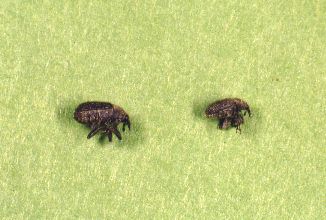
Gymnetron antirrhini: Photo by Greg McDermott, from slide show Biological Control of Noxious Weeds by Reeves Petrof.
Insect Links Photos: Adult Larva Eggs Damage to plant

Gymnetron antirrhini: Photo by Greg McDermott, from
slide show Biological Control of Noxious Weeds by Reeves
Petrof.
Origin
These weevils were introduced in the1900's in
Life Cycle
1) during the winter it spends its time as an adult in leaf litter
or in toadflax (yellow mainly, or Dalmatian) seed capsules.
2) Adults emerge in spring, typically May - June.
3) Eggs are laid within toadflax flowers, inside the ovary wall.
4) Larval stage lasts from 3 to 5 weeks in the seed
capsules. Larvae feed on "inactivated," abnormal seeds.
5) The mature larvae construct oval cells within seed capsules
where pupation occurs.
6) After several weeks, adults eclose (emerge) and may feed on
toadflax shoots for a short period of time before entering
diapause (going dormant for the winter). By this time the
year-old adults have laid their eggs and are mostly dead.
7) Adults are about 2.5 mm long; the gray weevils feed on young
shoots and flowers of toadflax in late summer and early fall. (1,
2) (3, 4)
Damage to Host stage- Larval
seed feeding and somewhat adult feeding on young shoots and
flowers.
Plant
species- yellow toadflax and somewhat Dalmatian toadflax.
Location-
larval: attack immature seeds inside the seed capsules.
Adult: shoots and flowers. (1, 2)
It reduces yellow toadflax seed reproduction, but its effect on
Dalmatian toadflax is unclear. (3, 4)
Host Impact-Method- damage
shoots and flowers. Focus- they focus on mainly yellow
toadflax and not so much Dalmatian toadflax. (1)
Favorable Places
The most favorable places for theses insects are places with
heavily shaded areas with lots of rainfall. (1, 2)
Unfavorable Places
Unfavorable places would include areas lacking in heavily shaded
areas and/or with very little rainfall. (1, 2) They do not do as well in the cold
but can survive in the cold. (3, 4)
Collecting
You can collect these insects wherever there is yellow
toadflax. You will most likely find adults using a sweep
net. You can also collect them in insectaries with
permission from the person who owns the insectaries. (1, 2)
Transporting Them
To transport these insects when they are adults, place them in a
suitable container such as a paper can with some fresh toadflax
foliage and then keep them in a cooler with a small ice
pack. You can also transport infected seed capsules but
realize that you are transporting seeds as well. (1,2,3) Release in places where
there is lots of yellow toadflax; make sure there are heavily
shaded areas and lots of rainfall. Try to not put them
anywhere that it is very cold or prone to large quantities of snow
in the winter. (2, 3) Release the Dalmatian strain
where Dalmatian toadflax is present. (4)
Redistribution
It is best to use a sweep net on the yellow toadflax plants, sweep
low to the plant near the roots where they spent their time if it
is cold out. These weevils usually redistribute themselves
quite well by flight and tend to be found where ever yellow
toadflax occurs. (2, 3) The Dalmatian strain
seems to be spreading on Dalmatian toadflax in our part of SW
Montana and is collectable in the same way. (4)
Links:
http://ceris.purdue.edu/napis/bio/gyan/index.html
http://www.nysaes.cornell.edu/ent/biocontrol/weedfeeders/gymnetron_antirrhini.html
http://sci.agr.ca/lethbridge/weedbio/agents/agymnet_e.htm
http://www.forestryimages.org/browse/detail.cfm?imgnum=0024013
http://www.aphis.usda.gov/ppq/permits/tag/petition.html
http://www.npwrc.usgs.gov/resource/plants/explant/linavulg.htm
http://weeds.ippc.orst.edu/pnw/weeds?02W_BIOC03.dat
http://scarab.msu.montana.edu/People/RKDPeterson/Sing_et_al._2005.pdf
Bibliography
1) Biological Control Agent Matrix, 1997, Ministry of Forests,
2) Hansen, Rich,
USDA-APHIS-PPQ, Forestry Sciences Lab,
3) Arnold, R. M.
1982. Pollination, predation and seed set in Linaria vulgaris (Scrophulariaceae). American
4) Breitenfeldt, Todd
A., Personal Interview, Whitehall Schools, P.O. Box 1109,
Whitehall, Mt, 59759, (406) 287-4862, 9-14-99.
By: Zach Housman last
updated
by: Sari Dersam 6/16/16
Published By: Matt Jensen